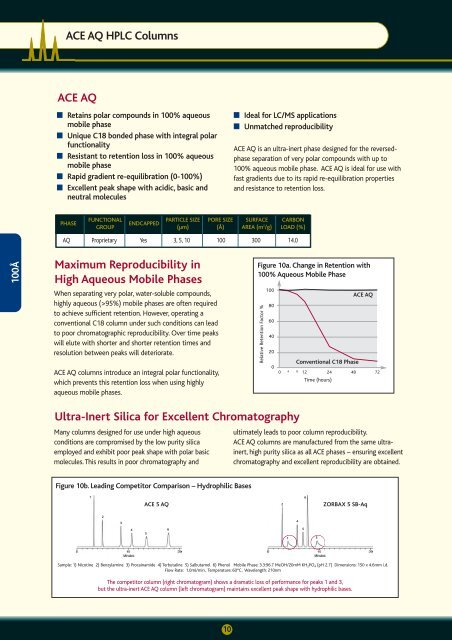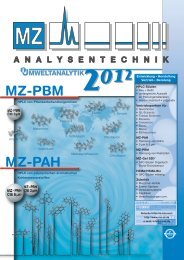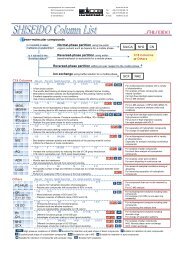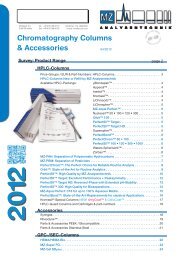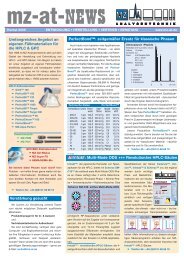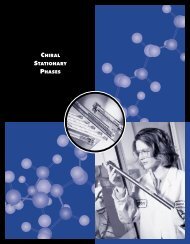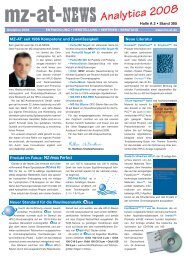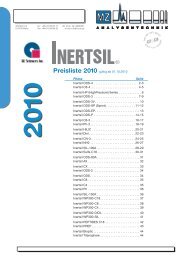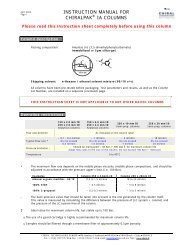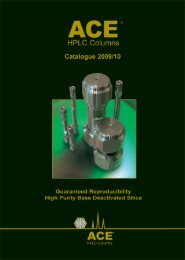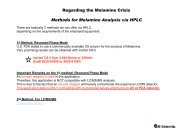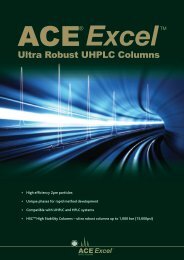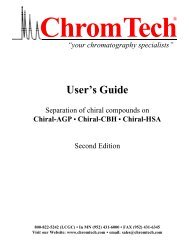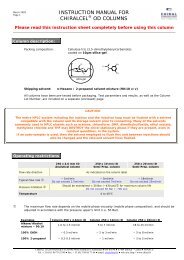Create successful ePaper yourself
Turn your PDF publications into a flip-book with our unique Google optimized e-Paper software.
100Å<br />
<strong>ACE</strong> AQ HPLC Columns<br />
<strong>ACE</strong> AQ<br />
■ Retains polar compounds in 100% aqueous<br />
mobile phase<br />
■ Unique C18 bonded phase with integral polar<br />
functionality<br />
■ Resistant to retention loss in 100% aqueous<br />
mobile phase<br />
■ Rapid gradient re-equilibration (0-100%)<br />
■ Excellent peak shape with acidic, basic and<br />
neutral molecules<br />
FUNCTIONAL<br />
PHASE ENDCAPPED<br />
GROUP<br />
PARTICLE SIZE<br />
(µm)<br />
PORE SIZE<br />
(Å)<br />
10<br />
■ Ideal for LC/MS applications<br />
■ Unmatched reproducibility<br />
<strong>ACE</strong> AQ is an ultra-inert phase designed for the reversedphase<br />
separation of very polar compounds with up to<br />
100% aqueous mobile phase. <strong>ACE</strong> AQ is ideal for use with<br />
fast gradients due to its rapid re-equilibration properties<br />
and resistance to retention loss.<br />
SURF<strong>ACE</strong><br />
AREA (m 2 /g)<br />
CARBON<br />
LOAD (%)<br />
AQ Proprietary Yes 3, 5, 10 100 300 14.0<br />
Maximum Reproducibility in<br />
High Aqueous Mobile Phases<br />
When separating very polar, water-soluble compounds,<br />
highly aqueous (>95%) mobile phases are often required<br />
to achieve sufficient retention. However, operating a<br />
conventional C18 column under such conditions can lead<br />
to poor chromatographic reproducibility. Over time peaks<br />
will elute with shorter and shorter retention times and<br />
resolution between peaks will deteriorate.<br />
<strong>ACE</strong> AQ columns introduce an integral polar functionality,<br />
which prevents this retention loss when using highly<br />
aqueous mobile phases.<br />
Ultra-Inert Silica for Excellent Chromatography<br />
Many columns designed for use under high aqueous<br />
conditions are compromised by the low purity silica<br />
employed and exhibit poor peak shape with polar basic<br />
molecules. This results in poor chromatography and<br />
Figure 10b. Leading Competitor Comparison – Hydrophilic Bases<br />
1<br />
2<br />
3<br />
4<br />
Figure 10a. Change in Retention with<br />
100% Aqueous Mobile Phase<br />
Relative Retention Factor %<br />
100<br />
80<br />
60<br />
40<br />
20<br />
0<br />
Conventional C18 Phase<br />
0 4 8 12 24 48 72<br />
Time (hours)<br />
<strong>ACE</strong> AQ<br />
ultimately leads to poor column reproducibility.<br />
<strong>ACE</strong> AQ columns are manufactured from the same ultrainert,<br />
high purity silica as all <strong>ACE</strong> phases – ensuring excellent<br />
chromatography and excellent reproducibility are obtained.<br />
<strong>ACE</strong> 5 AQ 2<br />
ZORBAX 5 SB-Aq<br />
5<br />
6<br />
Sample: 1) Nicotine 2) Benzylamine 3) Procainamide 4) Terbutaline 5) Salbutamol 6) Phenol Mobile Phase: 3.3:96.7 MeOH/20mM KH 2PO 4 (pH 2.7) Dimensions: 150 x 4.6mm i.d.<br />
Flow Rate: 1.0ml/min, Temperature: 60°C, Wavelength: 210nm<br />
The competitor column (right chromatogram) shows a dramatic loss of performance for peaks 1 and 3,<br />
but the ultra-inert <strong>ACE</strong> AQ column (left chromatogram) maintains excellent peak shape with hydrophilic bases.<br />
1<br />
4<br />
5<br />
6<br />
3


